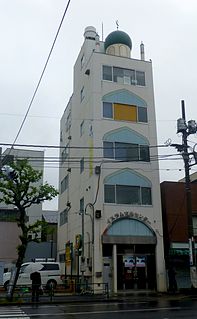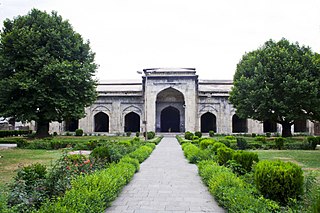
Faisal Mosque is a mosque in Islamabad, Pakistan. It is located on the foothills of Margalla Hills in Islamabad, the mosque features a contemporary design consisting of eight sides of concrete shell and is inspired by a Bedouin tent. The mosque is a major tourist attraction, and is referred as a contemporary and influential feature of Islamic architecture.

The Charminar, constructed in 1591, is a monument and mosque located in Hyderabad, Telangana, India. The landmark has become a global icon of Hyderabad, listed among the most recognized structures of India. Charminar has been a historical place with Mosque on the top floor for over 400 years and also known for its surrounding markets. It is one of the tourist attractions in Hyderabad. It is where many famous festivals are celebrated, such as Eid-ul-adha and Eid-ul-fitr.

Phulwari Sharif is a notified area in Patna in the Indian state of Bihar. The current metro plan of Patna has one route in Phulwari Sharif. The civilization of the city dates back to the days of inception of the Sufi culture in India. Phulwari Sharif had been frequented by most Sufi saints of that period. All India Institute of Medical Sciences Patna is located in Phulwari Sharif.
Masjid An-Nahdhah, is a mosque located in Bishan. The mosque was the sixth to be built under Phase III of the Mosque Building Fund program. Opened on January 6, 2006, it can accommodate about 4,000 worshippers.
In the Lal Masjid bombing of 6 July 2008 at 7:50 pm local time, a 30-year-old suicide bomber blew himself up near the Lal Masjid mosque in Islamabad, the capital of Pakistan, killing 18 policemen and 1 civilian. The bombing occurred on the first anniversary of the Siege of Lal Masjid and was likely a revenge attack. The attack occurred even amid tight security in Islamabad, where thousands of Islamic students in Pakistan came to mark the day when Pakistani troops stormed Lal Masjid. Pakistani Interior Minister Rehman Malik, who visited the blast site, said about 12,000 students attended the rally and the attack was directed at police.
Sher Shah Suri Masjid, mosque, Patna,also known as Shershahi, is an example of the Afghan style of architecture.Sher Shah Suri built this mosque in 1540–1545 to commemorate his reign.It is sited in the south-west corner of Purab Darwaza near Dhawalpura.
Tourism in Patna is refers to tourism in capital city of Bihar state in India. Patna is known for its tourist destinations and people across the state and abroad visits Patna. This article deals with major tourist attractions in Patna.

Moth Ki Masjid is a heritage building located in Delhi, and was built in 1505 by Wazir Miya Bhoiya, Prime Minister during the reign of Sikander Lodi (1489–1517) of the Lodi dynasty. It was a new type of mosque developed by the Lodis in the fourth city of the medieval Delhi of the Delhi Sultanate. The name of the mosque literally translated into English language means ‘Lentil Mosque’ and this name tag ‘Lentil’ has an interesting legend. This mosque was considered a beautiful Dome (Gumbad) structure of the period.

Chinese Mosque, Rantau Panjang or Sultan Ismail Petra Silver Jubilee Mosque and Beijing Mosque is a Chinese-style mosque in Rantau Panjang, Kelantan, Malaysia.
The Jama Masjid is a mosque built in 1612 AD, located near the Killa Arrak in Aurangabad, Maharashtra, India. It is historically significant because it was constructed in 1612 AD, very soon after the foundation of Aurangabad by Malik Amber in 1610 AD. The mosque was later extended by Aurangzeb(R.H) in the year 1692 AD, it is one of the oldest mosques of Aurangabad which is still in good condition.

Croydon Mosque & Islamic Centre is a mosque situated in Croydon, London. The organization, Muslims in Britain, classify the Croydon Masjid as Deobandi.

Ashok Rajpath is a road in Patna, the capital of Bihar. It is named after Ashoka, an Indian emperor of the Maurya Dynasty who ruled almost all of the Indian subcontinent from ca. 269 BCE to 232 BCE. It connects Patna with Patna city or Patna Sahib. Starting roughly from Golghar, it run parallel to the river Ganges, and terminates at the Didarganj. It is a busy road owing to the presence of markets on one side and educational institute of Patna University on the other side. It has several historical places either side of it, like Golghar, Gandhi Maidan, Christ Church, Kargil Chowk, Patna University including Patna Science College, Patna College and other colleges, PMCH, National Institute of Technology, Patna, Pathar Ki Masjid, Government Polytechnic Patna-7, Takht Shri Harmandir Saheb etc. The area is patrolled by the Pirbahore PS of Patna Police.

Daar Al-Arqam Mosque or commonly known as Masjid Asakusa is a mosque located in downtown Tokyo that was built in 1998. Asakusa Masjid Mosque is managed by the Japan Mosque Foundation (JMF) which is one of the departments in the institute Islamic Circle of Japan.

The Yusof Ishak Mosque is a mosque in Woodlands, Singapore. It was announced by Prime Minister, Mr. Lee Hsien Loong during the 2013 National Day Rally This new mosque is located at Woodlands Drive 17. The mosque is named after Singapore's first President, Yusof Ishak.

Pathar Masjid, known locally as Naev Masheed, is a Mughal era stone mosque located in the old city of Srinagar, in the Indian state of Jammu and Kashmir. It is located on the left bank of the River Jhelum, just opposite the shrine of Khanqah-e-Moula. It was built by Mughal Empress Noor Jehan, the wife of emperor Jehangir. The mosque has some distinct features that separate it from the rest of the mosques in the Kashmir Valley. Unlike other mosques, it does not have the traditional pyramidal roof. Furthermore, the mosque has nine mehraabs (arches), with the central one being larger than the others.
Masjid Alkaff Kampung Melayu, is a mosque located on the junction of Kaki Bukit Avenue 1 and Bedok Reservoir Road in Bedok, Singapore. The institution mainly serves worshippers from the Bedok Reservoir area.

New Karbigahiya or simply Karbigahiya is a neighbourhood in the central section of Patna in the eastern state of Bihar in India. It is located on the south side of Patna Junction and also serves as direct access point for platforms of the railway station. It is one of the busiest pedestrian and automobile areas in the city of Patna as a lot of vehicular traffic flows from the railway station to city and main bus stand of Patna. The neighbourhood also has an auto stand known as Karbigahiya auto stand.















